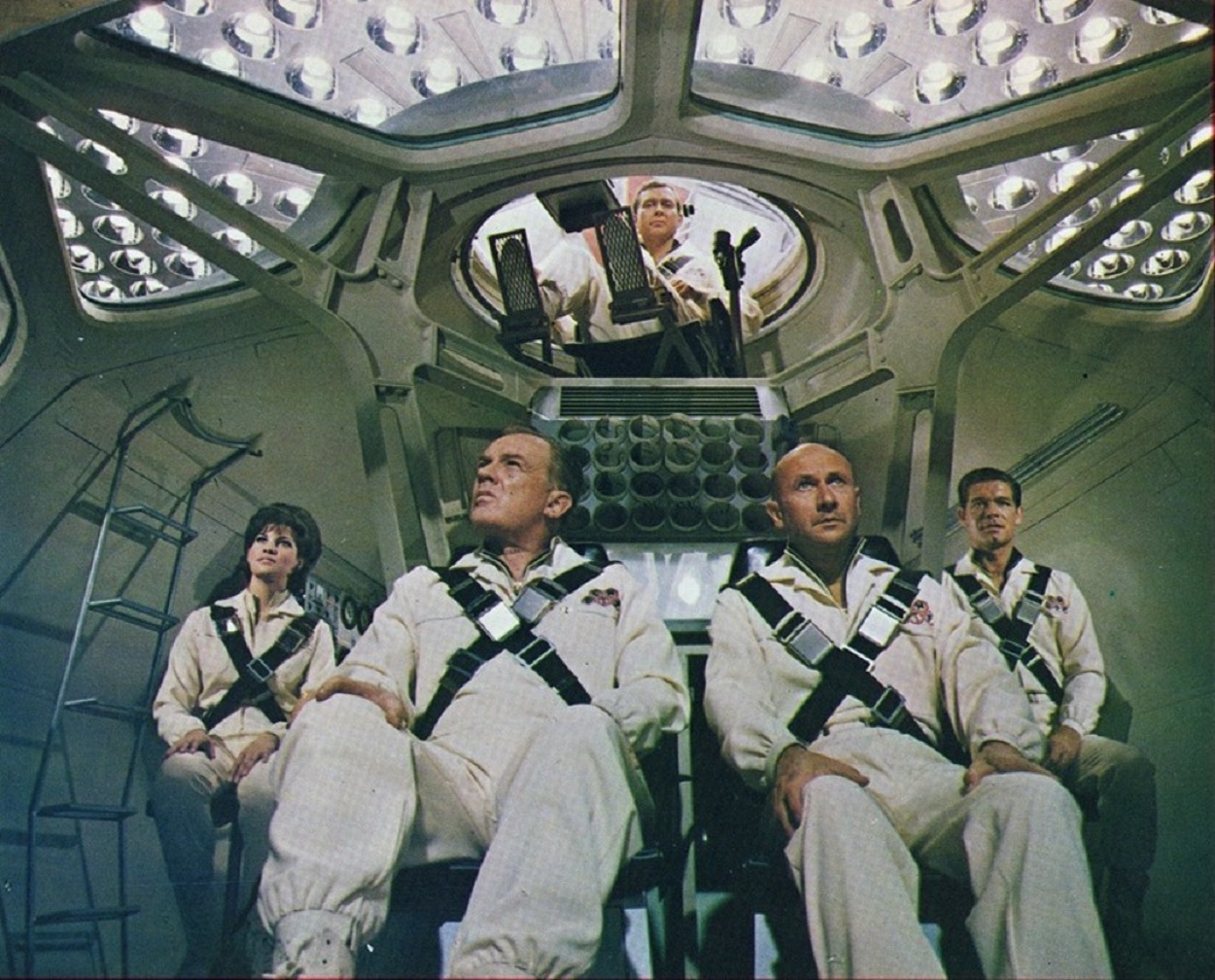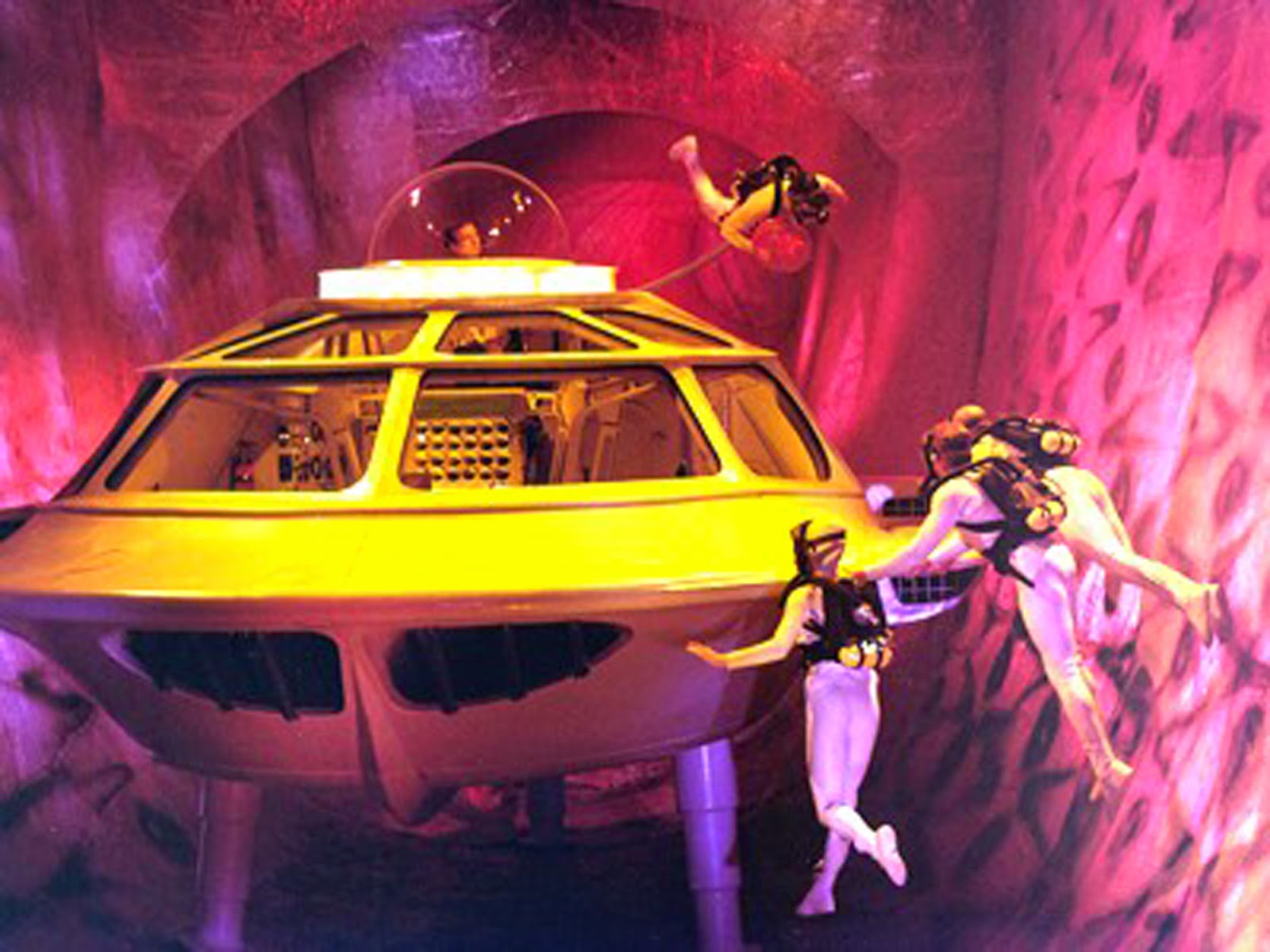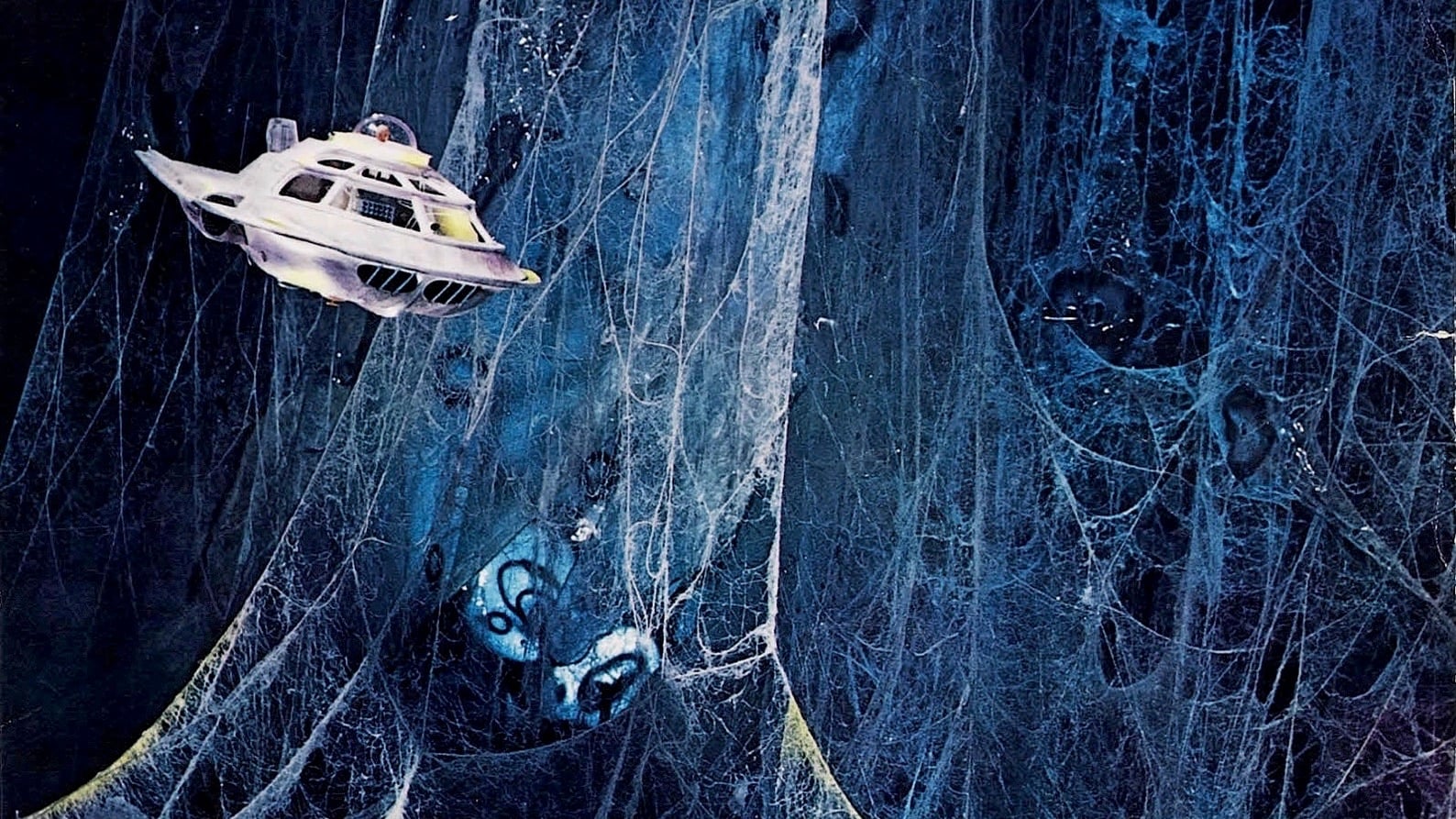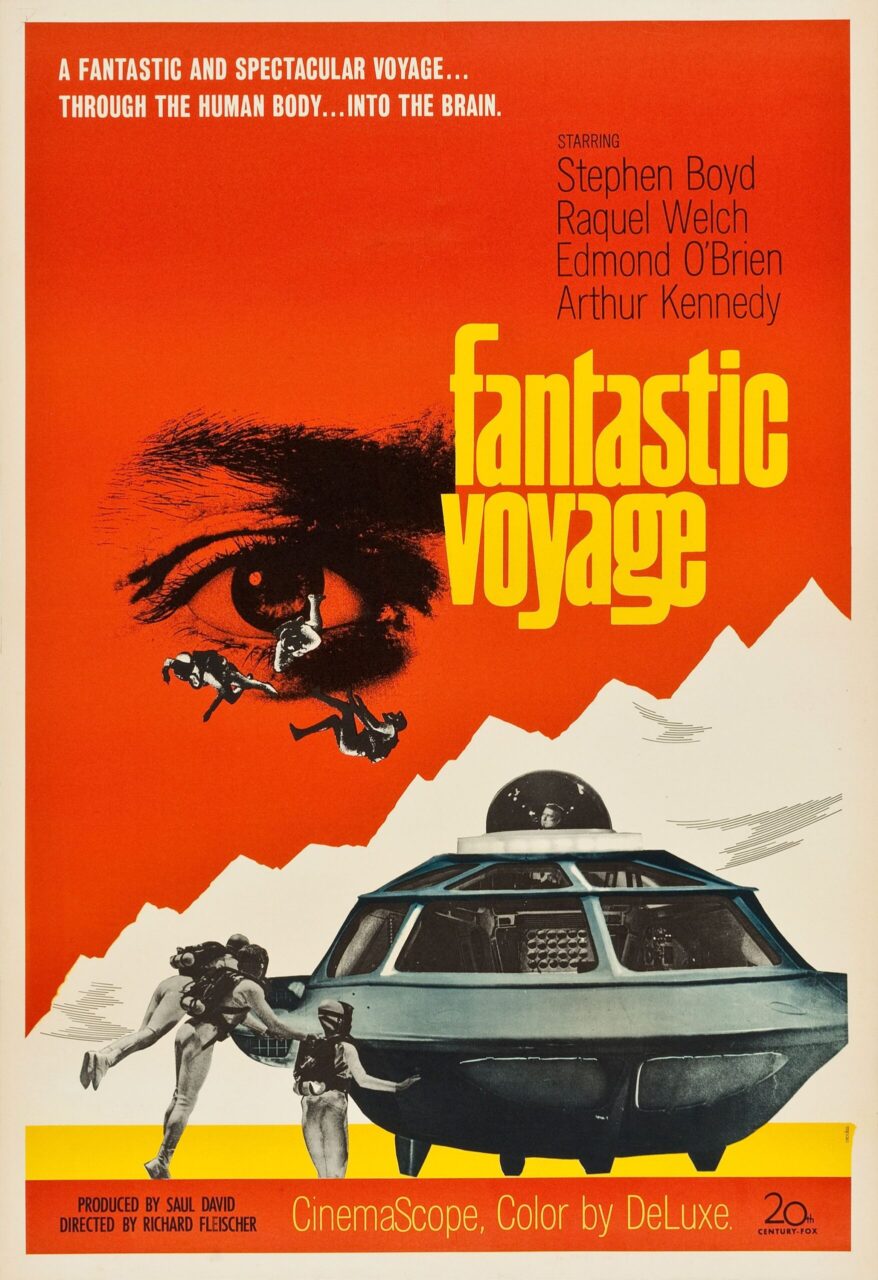USA. 1966.
Crew
Director – Richard Fleischer, Screenplay – Harry Kleiner, Adaptation – David Duncan, Story – Jay Lewis Bixby [Jerome Bixby] & Otto Klement, Producer – Saul David, Photography – Ernest Laszlo, Music – Leonard Rosenman, Photographic Effects – L.B. Abbott, Art Cruickshank & Emil Kosa Jr, Art Direction – Dale Hennesy & Jack Martin Smith, Submarine Design – Harper Goff. Production Company – 20th Century Fox.
Cast
Stephen Boyd (Charles Grant), Raquel Welch (Cora Peterson), Donald Pleasence (Dr Maxwell Michaels), Arthur Kennedy (Dr Peter Duval), William Redfield (William Owens), Edmond O’Brien (General Carter), Arthur O’Connell (Colonel Reid)
Plot
Scientist Jan Benes defects to the West but an attempted assassination by the other side places him a coma. Agent Charles Grant is recruited by the top-secret organisation Combined Miniaturized Deterrence Forces. He learns that he is to be part of a crew aboard a submarine The Proteus. The crew and submarine will be reduced to microscopic size and injected into the Benes’s bloodstream in order to operate on the surgically inaccessible clot in his brain using a laser. Injected into the body, Grant and the surgical team travel through the bloodstream in the submarine, marvelling at the wonders of the human body seen on a microscopic level. They must reach the brain within 60 minutes or else the effect will wear off and they will return to full-size. However, the voyage is undermined by one of the crew who is an enemy saboteur and is prepared to risk everything to stop the mission.
Fantastic Voyage is one of my all-time favourite science-fiction films. It is one of the most ingenious pieces of pure conceptual science-fiction poetry that the genre has ever created. One can ridicule its problems and holes, which are manyfold, but it is impossible to argue with the conceptual brilliance of the film, the sheer imaginative splendour of the idea of conducting a journey by miniaturised submarine through the human body. The script, which comes in part from science-fiction writer Jerome Bixby, knows exactly what a sense of wonder is. The film creates an amazing view of the human body as a veritable Aladdin’s cave of marvels, more wondrous, colourful and lit up than it could possibly ever be in real life. Even if the superb sets and effects are occasionally beset by grainy mattes lines and the visibility of wires, the imagination of the exercise soars. It is a pure celebration of science-fiction as conceptual poetry rather than as science. Indeed, Fantastic Voyage is an object lesson in what science-fiction can do on screen that the written page can never replicate.
Jerome Bixby originally envisioned the film as a Jules Verne-styled period piece a la the fad for retro-Victorian science-fiction created by Fantastic Voyage director Richard Fleischer’s own 20,000 Leagues Under the Sea (1954). This would have been fascinating – but it was changed during rewriting and the film updated into the Space Age. Now it echoes with the sense that humanity was on the frontier of taking a quantum leap forward and conquering the whole universe. “Maybe the ancient philosophers were right – man is the centre of the universe. Man stands between inner and outer space and there is no limit to either,” says Arthur Kennedy’ Duval during one of his many such pronouncements.

The film is almost a hymn to Space Age technology. Richard Fleischer follows the operation with wonderfully methodical exactitude – the journey through the vast labyrinth by golf cart, the operation being monitored by characters in lab coats on blinking, whirring computers, the submarine slowly being placed on an hexagonal dais, the pickup trolley being wheeled in and the submarine being shrunken in a glass tube and then connected to a syringe. The sense of detail and detached clinicism to the operation is enthralling. Contrast this to the wave of hand that usually produced marvels of super science in 1950s science-fiction or the heated fervour of madness under which discovery was conducted in 1930s and 40s mad scientist films – there is the sense that the future is here right now.
Once inside the body, Fantastic Voyage is dramatically construed as a series of set-pieces involving journeys to a particular part of the body whereupon something goes wrong with regular predictability. It is the things going wrong that makes the story dramatically gripping. The scenes navigating through the temporarily stopped heart, the manned venture into the lungs, and especially the seat-edge suspenseful passage through the inner ear as everybody in the operating room has to remain absolutely still and not make a sound lest they cause the inner ear to vibrate are utterly gripping.
Unfortunately, in the numerous re-writings the script clearly underwent, not much attention was paid to the characters. These are all written to type – the square-jawed jock hero, the curvaceous token female, the atheistic traitor. Stephen Boyd and Raquel Welch, in her first leading role, are both wooden, although this is not a film where one has come expecting penetrating character depth. What is worse is the character of Duval the surgeon who has no other purpose than to stand around and delivers ponderous pronouncements about “the miracle of life.” “40 million beats a year,” someone comments in reference to the heart, to which his reply is “All that stands between man and eternity.” It is a not particularly subtle debate – the side of good shows religious awe at the miraculous nature of the human body, while the contrary opinion represents godless atheism and is ultimately revealed as being a Communist traitor (even if Communism is not directly referred to in the film), not to mention is also the perpetual voice of cowardice and defeatism on the mission.

You cannot deny that there are numerous logic holes in the film. One can forgive minor quibbles such as the impossibility of squeezing normal-size air molecules into a micro-sized snorkel, or how surface tension would make it extremely difficult to swim inside a tear. However, there is one gaping hole that you could drive a full-size submarine through and that is this:– the film establishes that it is necessary that the operation be completed within a 60 minute limit otherwise the crew and submarine will return to full-size. (Interestingly, the dramatics of the journey take longer than 60 minutes to occur on screen). However, at the end of the film, the crew return to full-size but somehow leave a submarine and the body of the traitor behind in Benes’s brain after both have been consumed by a white blood cell. Do the filmmakers somehow think that being consumed by a white blood cell will fail to cause them to return to full size?
Not to mention the fact that at some point between when they complete the operation and swim out, the crew also discard the laser inside the brain. Everybody also seems to have forgotten about the fact that a six foot tall cylinder of water was reduced to the size of a syringe and injected into Benes – indeed, the amount of water injected into Benes’s body is far more than his body mass, which would surely cause him to literally explode when it too returns to normal size.
At least, the producers had the good sense to recruit science-fiction writer Isaac Asimov to write the novelisation Fantastic Voyage (1966), which is one of the finest in the usually creatively impoverished arena of film novelisations, wherein Asimov patched up many of the scientific and plot holes. For all its logical failings, Fantastic Voyage is still one of the most ingenious pieces of total Hollywood bunkum.

There was a short-lived animated tv series Fantastic Voyage (1968-9). There have been plans in the 1990s and sporadically throughout the 2000s to mount a remake as directed by Roland Emmerich of Independence Day (1996) fame. James Cameron also expressed interest, although apparently Roland Emmerich rejected his script. The film was parodied in Joe Dante’s Innerspace (1987) and the Futurama episode Parasites Lost (2001). The basic premise of the miniaturised journey inside a body has been used in two Doctor Who stories The Invisible Enemy (1977) and Into the Dalek (2014), as well as the film Antibody (2002).
Richard Fleischer has directed a number of other genre films – Disney’s classic Jules Verne adaptation 20,000 Leagues Under the Sea (1954), the musical version of Doctor Dolittle (1967), The Boston Strangler (1968), the psycho-thriller See No Evil/Blind Terror (1971), the true life serial killer film 10 Rillington Place (1971), the over-populated future film Soylent Green (1973), Amityville 3-D (1983), and the Robert E. Howard adaptations Conan the Destroyer (1984) and Red Sonja (1985).
The story comes from Jerome Bixby, a writer who dabbled in a number of genres and different media during his career. Bixby wrote several novels, although is mostly known for his short stories. He delivered several scripts for genre movies, including Curse of the Faceless Man (1958), It! The Terror from Beyond Space (1958), The Lost Missile (1958) and The Man from Earth (2007). He also wrote several episodes of Star Trek (1966-9) and the famous It’s a Good Life episode of The Twilight Zone (1959-63), which was later remade as a segment of Twilight Zone – The Movie (1983). David Duncan was also a regular genre writer with the screenplays for the English-language version of Rodan the Flying Monster (1956), The Black Scorpion (1957), The Monster That Challenged the World (1957), Monster on the Campus (1958), The Thing That Couldn’t Die (1958), The Leech Woman (1960) and The Time Machine (1960). The actual screenwriter Harry Kleiner also wrote a number of classic films including Miss Sadie Thompson (1953), Carmen Jones (1953) and Bullitt (1968).
Trailer here


